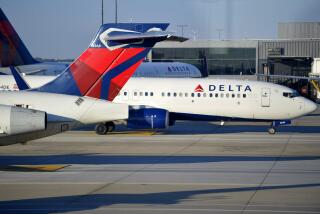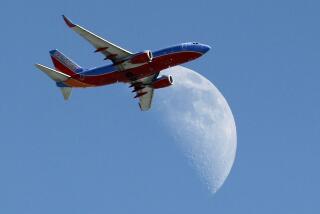A Barroom Brawl at 30,000 Feet Up? It Happens
- Share via
Item: On Oct. 20, in a United first-class cabin somewhere between Buenos Aires and New York, a businessman is accused of drunkenly assaulting a flight attendant, defecating on an in-flight service cart, and tracking feces throughout the plane.
Item: On a Dec. 18 flight from London to Minneapolis, a food fight erupts in a Northwest Airlines jet, and upon arrival in Minnesota 17 travelers are sent back across the Atlantic amid reports of drunken confrontations and children being instructed to steal liquor bottles.
Question: Just how many drinks is a person allowed on a commercial flight anyway?
Answer: The sky’s the limit, at least until you begin to terrorize your seatmates. After that, it’s a judgment call that depends on your flight attendant and cockpit crew.
U.S. airlines maintain that the horror stories above are isolated cases, and say troublesome drunkenness in the skies is rare. In part because of that, the airlines say, they have no consistent limit on the amount of beer, wine or other liquors that a passenger may be served. Another possible factor in this decision, though airline representatives don’t volunteer it, is that major carriers make millions of dollars yearly on alcoholic beverage sales.
At any rate, airlines give flight attendants the responsibility of deciding when to cut off a disruptive traveler. And that, as attendants are quick to point out, is no easy job.
“In a bar when a person is asked to leave, they can do so,” notes Meg Leith, air safety and health coordinator for the Washington-based Assn. of Flight Attendants, which represents about 36,000 employees of United, USAir, Alaska, Hawaiian and other airlines.
“In an airplane, there’s a big catch. They can’t leave. So we can get stuck with some pretty loud and obnoxious and angry passengers, who can become abusive. Over the last year, it seems to be escalating, and we’re not sure why. Maybe people are more frustrated at the world in general, and taking it out on the airplane.”
A spokesman for Alaska Airlines, on the other hand, says attendants there have sensed a decline in troublesome drunks in the last year or so. None of the airlines contacted for this story could offer any figures on how frequently passengers are cut off from alcohol. Police at Los Angeles International Airport say they are called about once a week to take an intoxicated traveler off a plane.
Here are several trends that flight attendants and airline representatives do agree upon:
Most troublesome drunks are men, and Leith notes that a substantial number of bothersome passengers later write “onion letters” (complaints to the airline) critical of flight attendants’ behavior. Attendants say the flights most likely to produce troublesome drunks are those carrying groups to vacation destinations, although the Los Angeles-New York corridor (busiest domestic route in the United States, with about 2.8 million passengers annually) gets its share of bothersome individuals. Occasionally problems arise with European travelers in coach class, who may be accustomed to the free liquor offered on many Europe-based carriers.
In individual cases on scheduled commercial flights, most airlines follow the same general procedures: Alcohol service is limited to travelers at least 21 years old. In some cities with laws banning alcohol service in the morning, drinks aren’t served until the plane is in the air. If a drinking passenger is disturbing his seatmates or the flight attendant, the flight attendant can cut off alcohol service to the offending passenger. If necessary, the attendant can summon the supervising attendant or a member of the cockpit crew to give a troublesome traveler a talking-to.
If the intoxicated traveler continues to make trouble after being denied more drinks, attendants consult with the cockpit crew, who may take an active role in the situation. (On American and Alaska airlines, plastic handcuffs are part of the standard cabin kit.) Often, cockpit crews arrange for FBI agents or other security officers to meet a plane and take the offending passenger into custody. Penalties can be severe; interfering with a flight attendant’s duties is a federal offense.
“Most passengers don’t really realize that one drink counts as two drinks when you’re up in the air dealing with the altitude and things like that,” says a spokesman for the Assn. of Professional Flight Attendants (APFA). Once that one or two drinks has evolved into four or five, the spokesman says: “Usually the passengers fall asleep or get sick on themselves. One way or another, they settle down.”
There’s another possible factor in all this: “They’re now serving less food on these planes,” says David Stempler, aviation industry consultant and passenger’s advocate based in Washington. As cost-conscious carriers have cut back on food service in the last two years, Stempler said, they may be finding that the effects of alcohol are amplified for travelers with empty stomachs.
Reynolds travels anonymously at the newspaper’s expense, accepting no special discounts or subsidized trips. To reach him, write Travel Insider, Los Angeles Times, Times Mirror Square, Los Angeles 90053.
More to Read
Sign up for The Wild
We’ll help you find the best places to hike, bike and run, as well as the perfect silent spots for meditation and yoga.
You may occasionally receive promotional content from the Los Angeles Times.







